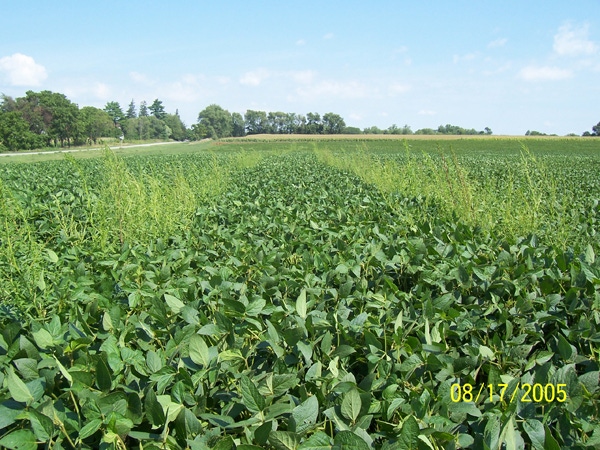July 20, 2016

Management options for weed escapes in soybeans are limited at this point in the growing season. The goal is to prevent the spread of Palmer amaranth and waterhemp before and during harvest.
This is the time of year that farmers and consultants start to notice infestations of our new invasive pigweeds as they climb above the soybean canopy after surviving the POST herbicide (scroll down to first photo).
Herbicide solutions
The first reaction for most is to look for an herbicide solution, but this can be challenging. These populations are glyphosate resistant and many may also be ALS or group 2 herbicide resistant (Pursuit, Classic, etc.). Potential active soybean products are usually members of the Group 14 or PPO inhibitors like Cobra, Flexstar/Reflex, Cadet/Marvel, and Ultra Blazer.
However, thesonth re-crop restriction to corn, so applications beyond early July have a greater risk for herbicide carryover. With smaller infestations, consider walking the fields and removing the weeds by hand.
With some exceptions, most products should be applied no later than R2 (flowering). Among the Group 14 herbicides, Cobra (lactofen) allows application up to 45 days before harvest or R6 (full seed), Cadet or Marvel, 60 days, Flexstar/Flexstar GT/Reflex 45 days, and Ultra Blazer 50 days before harvest.
Seed production
Additionally, products that contain fomesafen (Flexstar/Reflex) have a 10-m14) herbicide to control smaller weeds and reduce weed seed production.
It is generally too early in late July for seed production, but do not transport plants away from the infested field and bury or burn plants that may contain viable seed. With small severe infestations, you may consider destroying the crop and the weeds by mowing and/or herbicide application. Dicamba plus or minus 2,4-D are probably the preferred products.
On dairy farms, perhaps the soybeans (or corn) could be harvested for silage, which may occur prior to Palmer amaranth seed production.
Harvest
Harvesting all plant material and ensiling should also kill some of the weed seeds that could be present as we move into the fall. It is very important not to allow Palmer amaranth seed to spread beyond the current infestation and to try to reduce the potential for new seed production.
The potential to spread this problem at harvest via the combine is great, so anything that can be done to control the pigweeds prior to crop harvest is imperative.
1. Apply a rescue PPO (Group e herbicides will generally not kill these larger, more mature plants.
2. Hand rogue lighter infestations and dispose of plants on field edge. “BAG IT” and bury or burn plants to prevent seed production and spread.
3. With small severe infestations, destroy the crop and weeds before seed set.
4. Harvest soybeans or corn for silage.
5. Do not combine harvest mature pigweeds. If combine harvest cannot be avoided, harvest infested fields last to avoid moving seeds away from the infested fields
6. Monitor field edges, ditches, and fencerows for noxious pigweed plants.
You May Also Like




